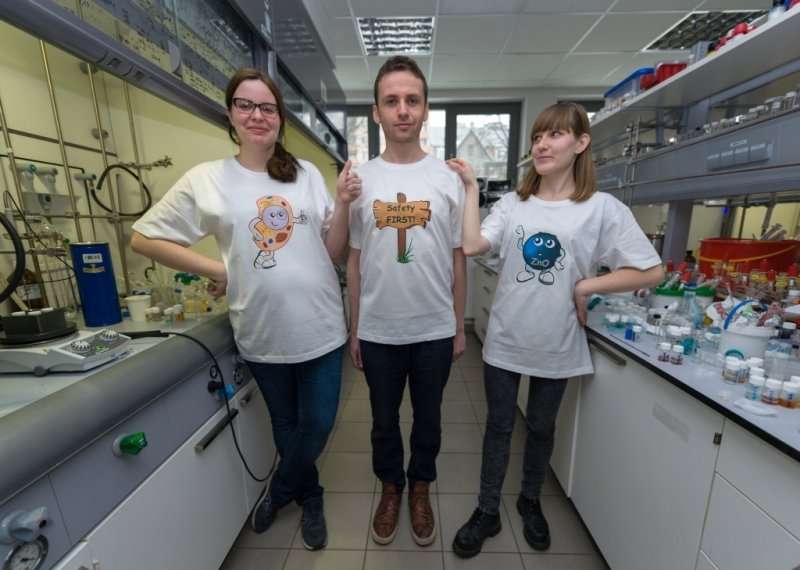New, safe zinc oxide quantum dots

Nowadays, zinc oxide nanoparticles are among the most commonly used nanomaterials. They seem to be safe for humans, but there are still no standards for their toxicity, and despite investigations, the toxicological impact of ZnO nanomaterials remains ambiguous. Researchers from the Polish Academy of Sciences (IPC PAS) in Warsaw and the Warsaw University of Technology (PW) have recently developed a method for producing defect-free ZnO quantum dots with enduring physicochemical properties such as monodispersity, a relatively high quantum efficiency, record-long luminescence lifetimes and EPR silence under standard conditions. The tightly coordinated and impermeable organic shells that stabilize the surface make the new ZnO quantum dots resistant to both chemical and biological environments.
"Our zinc oxide nanocrystals are of unprecedented high quality, characterized by significantly better chemical and physical properties than those currently being produced by the most popular sol-gel method involving inorganic precursors," says Prof. Janusz Lewinski (IPC PAS, PW). "The luminescence lifetime is much longer by up to several orders of magnitude. Moreover, until now, only short ZnO photoluminescence decays have been observed, on the order of a few to a dozen or so picoseconds, characteristic for sol-gel nanoparticles, or slightly longer, nanosecond ones, typical only for ZnO monocrystals."
Combined with biologically active molecules, the new nanoparticles could be used in biology or medicine, e.g. for imaging cells and tissues, which would enable much more accurate monitoring of disease development and efficacy of treatment. In an article published in Chemistry - A European Journal, the Warsaw scientists, in collaboration with a group from the Jagiellonian University in Cracow, showed that their zinc oxide nanoparticles are safe. The research could lead to rapid introduction of the new ZnO quantum dots for biological and medical laboratories and other applications.
ZnO nanocrystals manufactured in a classic manner by the sol-gel method are not well stabilized or isolated from the environment. For example, interactions that occur at the interface between the inorganic ZnO core and the biological environment can lead to the generation of reactive oxygen species or the dissolution and release of potentially toxic zinc cations.
"Zinc oxide is generally considered as a relatively safe and biocompatible material. However, many toxicological studies of ZnO concern nanoparticles that are heterogeneous in size and also too large to be able to penetrate into cells. We also realized that in practice, many of the characteristics of nanoparticles depend not only on their size, but also on the surface properties of both the nanocrystalline ZnO and the organic stabilizing layer. Therefore, we decided to modify our one-pot, self-supporting organometallic method of synthesis, so that the ZnO nanoparticles produced behave as neutrally as possible in the interior of the cells," says Dr. Malgorzata Wolska-Pietkiewicz (PW).
Prof. Lewinski's team produces quantum dots of zinc oxide from organometallic compounds (precursors). For biological applications, the end result is stable, spherical nanoparticles consisting of a crystalline ZnO core with a diameter of four to five nanometres surrounded by a shell of organic ligands. This shell increases the size of the nanoparticles (their hydrodynamic diameter is about 12 nm) and protects the inorganic core from degradation due to interaction with what is often a very reactive biological environment, while eliminating the influence of ZnO itself on this environment.
"Nanoparticles with core sizes below 10 nm penetrate inside the cells particularly easily. Such particles are considered to be potentially the most toxic. Interestingly, these ZnO nanoparticles showed extremely low harmful effects in in vitro model tests. The recent results, as well as the studies carried out simultaneously in the parent team, provided further evidence of the unique character of the nanocrystalline ZnO obtained as a result of the transformation of organometallic molecular precursors," notes Dr. Wolska-Pietkiewicz.
However, there are concerns about their biological and environmental impacts. Nanoparticles can enter the body—the respiratory tract is frequently exposed to elevated concentrations of nanomaterials is particularly vulnerable to toxicity. Therefore, A549 and MRC-5 cell lines were selected as in vitro models for internal malignancies and normal lung cells, respectively. Researchers from the IPC PAS and PW showed that the organic layer surrounding the improved nanoparticles is impermeable—zinc ions are not released into the environment, and reactive oxygen species are not formed. Even at high concentrations, the toxicity of the new ZnO nanoparticles turned out to be negligible.
"Our method for the production of ZnO quantum dots means that they simply do not interact with the biological environment. So we have a strong foundation on which to start working on their applications. Not only in medical imaging, but also in other areas in which nanoparticles could potentially interact with the human body, for example, as one of the components of paint. We are also developing a new technology for the synthesis of ZnO quantum dots and searching for potential applications as a part of NANOXO, a start-up company," summarizes Prof. Lewinski.
More information: Małgorzata Wolska-Pietkiewicz et al, Safe-by-Design Ligand-Coated ZnO Nanocrystals Engineered by an Organometallic Approach: Unique Physicochemical Properties and Low Toxicity toward Lung Cells, Chemistry - A European Journal (2017). DOI: 10.1002/chem.201704207
Journal information: Chemistry – A European Journal
Provided by Polish Academy of Sciences





















